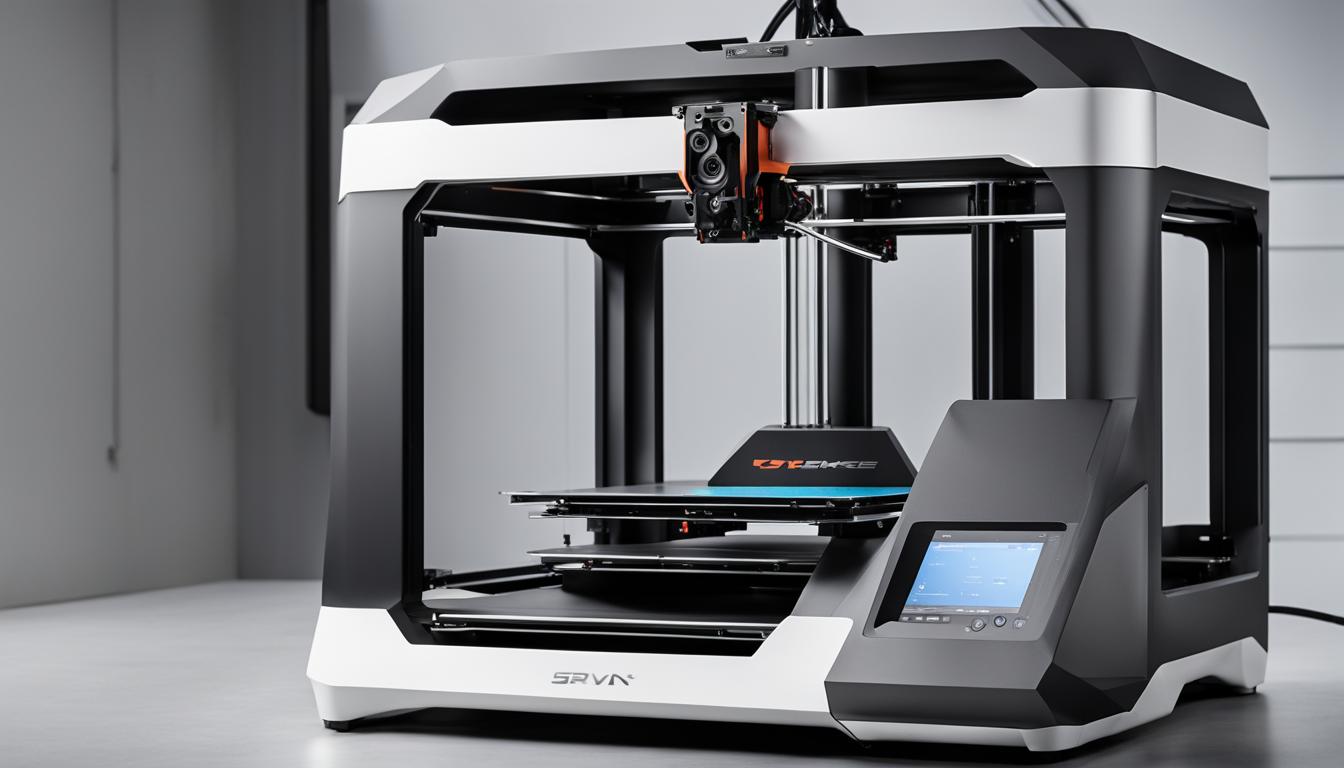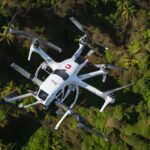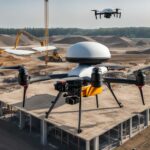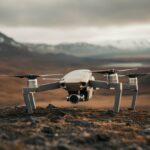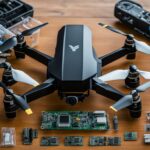Choosing the right 3D printer for making drones can be overwhelming with so many options available. This article will help you identify the best 3D printer options specifically designed for drone production. We will explore the features, specifications, and user experiences of top-rated 3D printers for building drones. Whether you are a beginner or an experienced 3D printer user, this guide will assist you in making an informed decision.
Key Takeaways: What is the Best 3D Printer for Making Drones?
- Choosing the right 3D printer for making drones is crucial for drone production.
- The Artillery Sidewinder X1 V4, Creality Ender 3 V2, and Anycubic Mega X are highly recommended 3D printers for drone manufacturing.
- Consider factors like build volume, printing speed, and user experience when selecting a 3D printer.
- There are various options for sourcing 3D-printed drone parts, including online services and local maker spaces.
- Joining a makerspace or hackerspace can provide access to 3D printers and a community of makers.
Artillery Sidewinder X1 V4
The Artillery Sidewinder X1 V4 is a highly recommended 3D printer for building drones. It offers a large build volume of 300 x 300 x 400mm, making it suitable for printing drone components of various sizes. With its rapid heating ceramic glass print bed, this printer ensures excellent adhesion and minimizes the risk of warping during the printing process. The direct drive extruder system guarantees precise filament control, resulting in high-quality prints. Additionally, the ultra-quiet stepper motor ensures a smooth and quiet operation, allowing for uninterrupted printing sessions.
Equipped with a filament detector sensor, the Artillery Sidewinder X1 V4 notifies users when the filament runs out, preventing failed prints. The LCD-color touch screen provides a user-friendly interface, making it easy to navigate through the printer’s settings and monitor the progress of your prints. In the event of a power outage, the print resume capability allows you to pick up where you left off and avoid wasting time and materials. The Artillery Sidewinder X1 V4 combines reliability, ease of use, and affordability, making it a top choice for drone manufacturing enthusiasts.

Specifications table: Artillery Sidewinder X1 V4
| Feature | Specification |
|---|---|
| Build Volume | 300 x 300 x 400mm |
| Print Bed | Rapid heating ceramic glass |
| Extruder System | Direct drive |
| Stepper Motor | Ultra-quiet |
| Filament Detector | Yes |
| Display | LCD-color touch screen |
| Print Resume | Yes |
With its impressive features and capabilities, the Artillery Sidewinder X1 V4 provides a high-quality 3D printing experience for drone construction. Its reliability, ease of use, and reasonable price make it a top choice for hobbyists and professionals alike. Whether you are a beginner or an experienced 3D printer user, this printer offers the versatility and performance needed to bring your drone designs to life.
Creality Ender 3 V2
The Creality Ender 3 V2 is a highly recommended 3D printer for drone manufacturing. It offers impressive features and capabilities that make it a top choice for building drones. With a build volume of 220 x 220 x 250mm, the Ender 3 V2 provides ample space for printing drone components with precision and accuracy. The printer also has a high-quality meanwell power supply, ensuring stable and reliable performance during the printing process.
One standout feature of the Creality Ender 3 V2 is its smart filament runout detection system. This feature automatically pauses the printing process when the filament runs out, allowing the user to replace it and resume printing without any loss of progress. The addition of built-in storage compartments and XY-axis tensioners further enhances the convenience and ease of use of this printer.
Users have praised the Creality Ender 3 V2 for its exceptional print quality and overall value for money. It delivers precise and detailed prints, making it ideal for intricate drone designs. The printer also boasts a maximum printing speed of 180mm/s, allowing for efficient and timely production of drone components. Whether you are a beginner or an experienced 3D printer user, the Creality Ender 3 V2 offers a user-friendly experience and reliable performance for drone manufacturing.
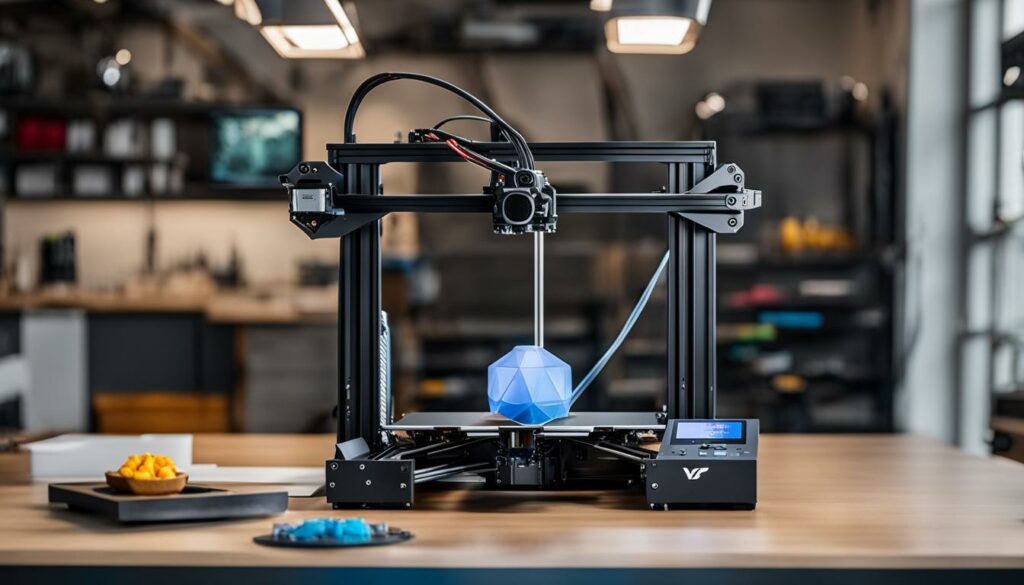
Comparison of Creality Ender 3 V2 with Artillery Sidewinder X1 V4 and Anycubic Mega X
| Feature | Creality Ender 3 V2 | Artillery Sidewinder X1 V4 | Anycubic Mega X |
|---|---|---|---|
| Build Volume | 220 x 220 x 250mm | 300 x 300 x 400mm | 300 x 300 x 305mm |
| Filament Runout Detection | Yes | Yes | Yes |
| Printing Speed | 180mm/s | N/A | N/A |
| Price | Affordable | Reasonable | High-end |
“The Creality Ender 3 V2 delivers excellent print quality and is a reliable choice for drone manufacturing.” – User Testimonial
- The Creality Ender 3 V2 offers a build volume of 220 x 220 x 250mm, making it suitable for printing drone components.
- With its smart filament runout detection system, the Ender 3 V2 automatically pauses printing when the filament runs out, ensuring uninterrupted production.
- Users have praised the Creality Ender 3 V2 for its exceptional print quality, user-friendly experience, and overall value for money.
- Comparison with other popular 3D printers for drone manufacturing, such as the Artillery Sidewinder X1 V4 and Anycubic Mega X, reveals its unique features and capabilities.
Anycubic Mega X: An Advanced 3D Printer for Drone Manufacturing
The Anycubic Mega X is one of the top choices for 3D printers used in drone assembly. With its advanced features and capabilities, this printer offers high-quality results and is suitable for both beginners and experienced users alike.
One of the standout features of the Anycubic Mega X is its large build volume of 300 x 300 x 305mm. This allows for the production of bigger drone models, providing greater flexibility and customization options for drone manufacturing.
Additionally, the printer boasts a rapid heating ultra base print bed, which ensures excellent adhesion and prevents print warping. This is crucial for achieving precise and accurate drone parts. The Anycubic Mega X also includes a filament runout detector, a z-axis dual screw rod design, and a 5-inch LCD touch screen, making it user-friendly and convenient to operate.
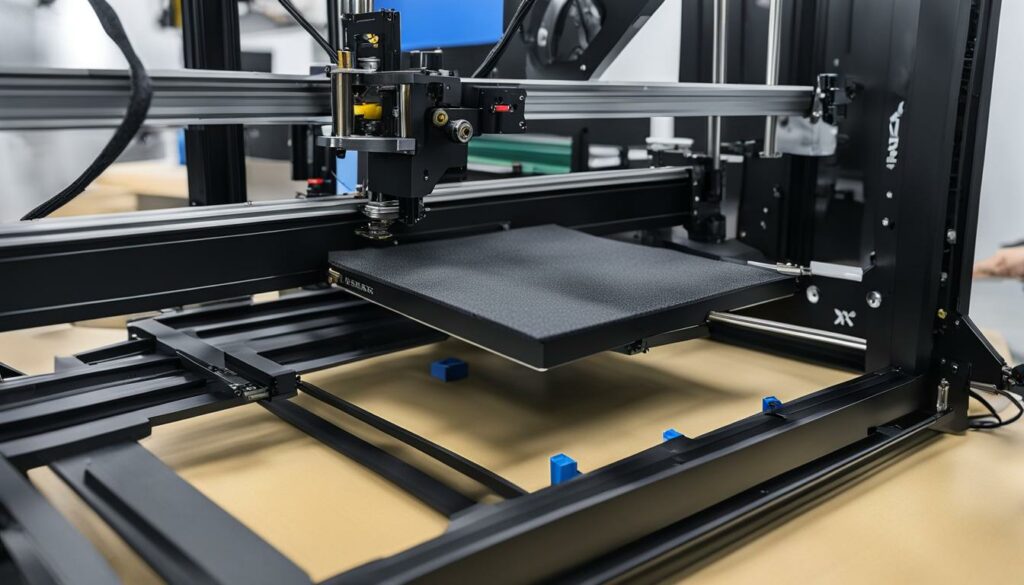
Key Features of the Anycubic Mega X:
- Large build volume of 300 x 300 x 305mm
- Rapid heating ultra base print bed
- Filament runout detector
- Z-axis dual screw rod design
- 5-inch LCD touchscreen
The Anycubic Mega X stands out for its sturdy metal frame, which ensures stability during the printing process, resulting in precise and reliable drone parts. The powerful titan extruder allows for smooth filament feeding, reducing the risk of clogs and improving overall print quality.
Furthermore, the printer features a smart resume print function, which is incredibly useful in the event of a power outage. It allows the printer to resume printing from where it left off, saving time and avoiding print failures. Overall, the Anycubic Mega X is a top-notch 3D printer that offers advanced capabilities and exceptional print quality, making it an ideal choice for drone manufacturing.
3D Printed Drones in Various Sectors
3D printing technology has brought significant advancements in the drone manufacturing industry, allowing for the production of custom drones tailored to specific sectors. The versatility and cost-effectiveness of 3D printing have opened up new possibilities in various fields, including military, disaster response, e-sports, and remote sensing.
Applications in the Military Sector
In the military sector, 3D printing has played a crucial role in the development of affordable and reliable drones for real-time image capturing. Military units can now deploy customized drones equipped with advanced imaging systems to gather intelligence and monitor potential threats. The ability to quickly produce drone components using 3D printing has significantly reduced costs and improved operational efficiency.
Disaster Response and Search Missions
During disaster scenarios, 3D-printed drones have proven invaluable for search and rescue missions. These drones are equipped with thermal imaging cameras and other sensors to detect survivors in hard-to-reach areas. The ability to rapidly manufacture drones and replacement parts through 3D printing ensures that rescue teams have the tools they need to save lives efficiently.
Other Sectors Benefiting from 3D Printed Drones
3D-printed drones have also found applications in sectors like e-sports and remote sensing. In the e-sports industry, custom-designed drones enable innovative aerial shots and dynamic footage during competitive events. In remote sensing, drones equipped with specialized sensors collect valuable data for environmental monitoring, agriculture, and infrastructure inspections.
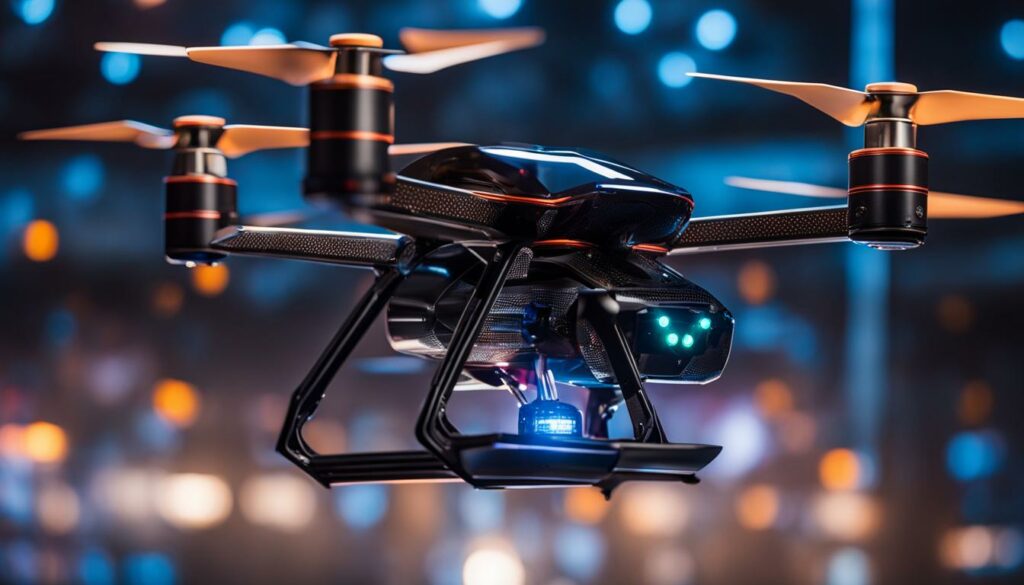
These examples highlight the diverse applications of 3D-printed drones across various sectors. The ability to customize drone designs and rapidly manufacture parts through 3D printing has revolutionized the way drones are used in different industries. As technology continues to advance, we can expect further innovations and advancements in the field of 3D printed drone manufacturing.
Where to Find 3D Printed Drone Parts
If you’re in need of 3D-printed drone parts, there are several options available to you. Local libraries often offer 3D printing services, allowing you to bring your designs and have the parts printed on-site. Additionally, reaching out to friends or colleagues who own 3D printers may also be a viable option. Schools and makerspaces are another great resource, as they typically have multiple 3D printers available for use.
Another convenient way to obtain 3D-printed drone components is by ordering them online. Services like Shapeways and 3DHubs allow you to upload your designs and have the parts delivered to your doorstep. This option is particularly useful for those who don’t have access to a 3D printer or need specialized parts that may be challenging to produce independently.
For those who prefer complete control over the printing process, purchasing your own 3D printer is a viable option. This allows you to print parts whenever you need them and experiment with different materials and designs. Popular 3D printer models for drone enthusiasts include the Prusa i3, Monoprice printers, and the DaVinci 1.0 Pro. Make sure to consider factors like build volume, resolution, and the ability to handle different materials when selecting a printer.
| Option | Pros | Cons |
|---|---|---|
| Local Libraries | – Convenient access to 3D printing services – Cost-effective option for one-off prints |
– Limited availability based on library operating hours and location – May have restrictions on printing materials |
| Friends or Colleagues with 3D Printers | – Access to printing services without additional costs – Potential guidance and support from experienced users |
– Dependence on the availability and willingness of others to assist – Limited range of printing materials and capabilities |
| Schools and Makerspaces | – Wide range of 3D printers available for use – Opportunities for learning and collaboration with like-minded individuals |
– Membership or usage fees may apply – Limited access based on operating hours and location |
| Online Services (Shapeways, 3DHubs) | – Allows for easy uploading and ordering of 3D-printed parts – Wide range of printing materials and finishes available |
– Longer turnaround times for production and delivery – Potential shipping costs and import duties depending on location |
| Purchasing a 3D Printer | – Complete control over the printing process and timeline – Ability to experiment with different materials and designs |
– Initial investment in the printer and materials – Requires technical knowledge for setup and maintenance |
Overall, the availability of 3D printing services and the option to purchase your own 3D printer make sourcing 3D-printed drone parts more accessible than ever. Whether you choose to utilize local resources, seek assistance from friends and colleagues, or explore online services, there are plenty of options to suit your needs and budget. With the right resources at your disposal, you can bring your drone designs to life and take your drone-building projects to new heights.
Buying a 3D Printer for Drone Manufacturing
When purchasing a 3D printer for drone manufacturing, there are several key considerations to keep in mind. Firstly, the build volume is an important factor as it determines the size of the drones you can print. Look for a printer with a large build volume that can accommodate your specific drone models.
Another important feature to consider is the printer’s bed heating capability. A heated bed is essential for ensuring proper adhesion of the 3D-printed parts, especially for materials like ABS. Additionally, automatic bed leveling is a useful feature that can save time and ensure accurate prints.
Printer resolution is another crucial aspect to consider. Higher-resolution printers produce more detailed and precise prints, resulting in smoother surfaces and better overall quality. This is particularly important for intricate and complex drone parts that require a high level of precision.
Lastly, it’s important to decide whether you want an open or closed printer. Open printers offer more flexibility and accessibility, allowing you to easily monitor the progress of your prints. On the other hand, closed printers provide a more controlled environment, minimizing external factors that can affect print quality, such as temperature and dust.
Table: Key Considerations for Buying a 3D Printer for Drone Manufacturing
| Consideration | Benefits |
|---|---|
| Large build volume | Accommodate larger drone models |
| Heated bed | Ensures proper adhesion of 3D-printed parts |
| Automatic bed leveling | Saves time and ensures accurate prints |
| High printer resolution | Produces detailed and precise prints |
| Open or closed printer | Flexibility vs. controlled environment |
By considering these factors and determining your specific needs, you can make an informed decision when buying a 3D printer for drone manufacturing. Remember to weigh the pros and cons of different models and choose the one that best suits your requirements and budget.
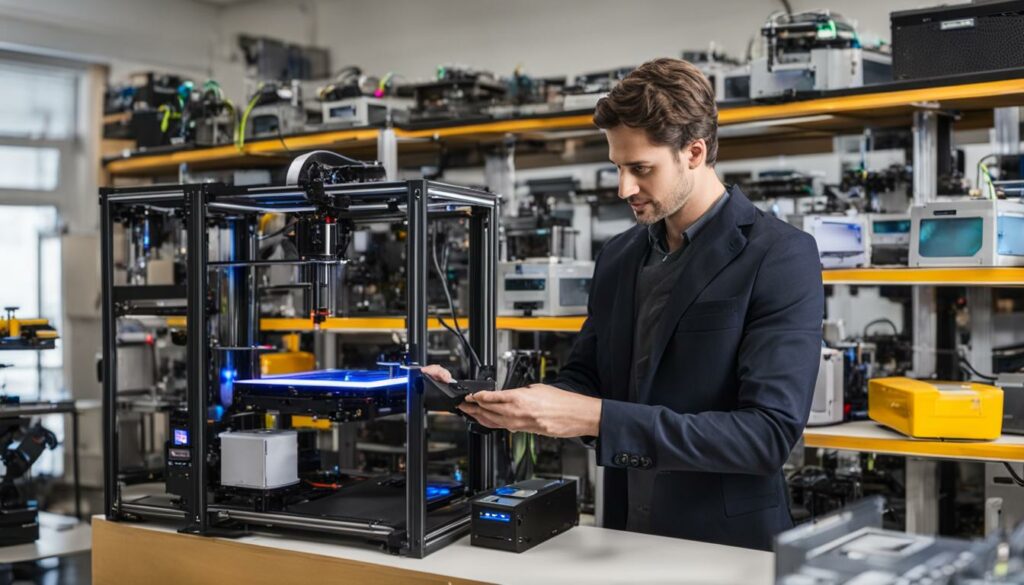
Joining a Makerspace or Hackerspace
If you’re interested in exploring the world of 3D printing but don’t have access to your own printer, joining a makerspace or hackerspace can be a fantastic solution. These collaborative environments provide individuals with shared access to a wide range of tools, including 3D printers, allowing you to bring your ideas to life without the need for a personal investment.
At a makerspace or hackerspace, you can connect with a community of like-minded individuals who are passionate about 3D printing and other creative endeavors. You can share knowledge, learn from experienced members, and collaborate on exciting projects. Being part of such a community provides a valuable support system, inspiration, and opportunities to enhance your skills.
Joining a makerspace or hackerspace is relatively straightforward. You typically pay a monthly subscription fee, which grants you access to the facilities and equipment. Some spaces may also offer workshops, classes, and events where you can further develop your skills and network with fellow enthusiasts. To find a makerspace or hackerspace near you, you can use online directories or reach out to local hobbyist groups.
So, if you’re eager to dive into the world of 3D printing and join a vibrant community, consider joining a makerspace or hackerspace. It’s a fantastic way to gain access to 3D printing resources, learn from others, and unleash your creativity. Who knows, you may even discover new passions and form lifelong friendships along the way!
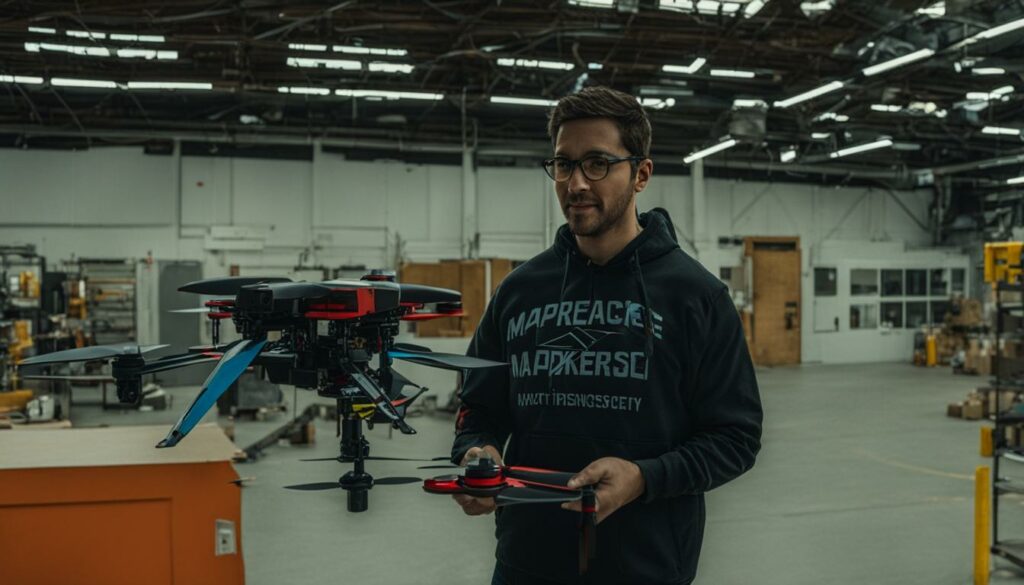
The Benefits of Joining a Makerspace or Hackerspace
Joining a makerspace or hackerspace offers numerous advantages for individuals interested in 3D printing. Here are some key benefits:
- Access to Equipment: Makerspaces and hackerspaces typically have a wide range of tools, including 3D printers, that you can use to bring your ideas to life.
- Learning Opportunities: You can attend workshops, classes, and events organized by the community to expand your knowledge and skills in 3D printing.
- Collaboration and Networking: Being part of a makerspace or hackerspace allows you to connect with like-minded individuals, share ideas, and collaborate on exciting projects.
- Support and Guidance: Experienced members of the community can provide guidance, mentorship, and troubleshooting assistance, helping you overcome challenges and learn from their expertise.
- Inspiration and Creativity: Surrounding yourself with fellow enthusiasts can spark new ideas, inspire creative thinking, and push the boundaries of what you can achieve with 3D printing.
Conclusion
After exploring the top 3D printers for drone manufacturing, it is clear that the Artillery Sidewinder X1 V4, Creality Ender 3 V2, and Anycubic Mega X are all excellent options to consider. Each printer offers unique features and capabilities that cater to different needs.
When making your decision, it is important to consider factors such as the build volume, printing speed, and user experience. The Artillery Sidewinder X1 V4 stands out for its large build volume and affordable price, making it a reliable choice. On the other hand, the Creality Ender 3 V2 impresses with its ease of use and overall value for money. Lastly, the Anycubic Mega X is a top choice for those seeking advanced capabilities in drone manufacturing.
If you don’t have access to a 3D printer, there are various options available for sourcing 3D-printed drone parts. You can consider joining a makerspace or hackerspace, where you can have access to multiple 3D printers without the need to invest in your own. Additionally, online services like Shapeways and 3DHubs allow you to upload your designs and have the parts delivered to your doorstep.
Ultimately, 3D printing technology offers endless possibilities for drone manufacturing. Whether you decide to buy a printer, join a makerspace, or utilize online services, choosing the right 3D printer for your drone production needs will allow you to create customized and high-quality drones for various sectors.
FAQ
What are the best 3D printers for making drones?
The Artillery Sidewinder X1 V4, Creality Ender 3 V2, and Anycubic Mega X are highly recommended options for drone manufacturing.
What are the key features of the Artillery Sidewinder X1 V4?
The Artillery Sidewinder X1 V4 offers a large build volume, rapid heating ceramic glass print bed, direct drive extruder system, and filament detector sensor.
What features does the Creality Ender 3 V2 have?
The Creality Ender 3 V2 features an open build space, a high-quality power supply, a smart filament runout detection system, and XY-axis tensioners.
What is unique about the Anycubic Mega X?
The Anycubic Mega X has a large build volume, rapid heating ultra base print bed, z-axis dual screw rod design, and a powerful titan extruder.
How has 3D printing revolutionized the drone industry?
3D printing has allowed for customized drones in various sectors, such as military, disaster scenarios, e-sports, and remote sensing.
Where can I find 3D-printed drone parts?
You can find 3D printed drone parts at local libraries, through friends or colleagues with 3D printers, at schools or makerspaces, or by ordering from online services like Shapeways or 3DHubs.
What factors should I consider when buying a 3D printer for drone manufacturing?
Consider the build volume, printing speed, bed heating, automatic bed leveling, resolution, and whether you want an open or closed printer.
How can joining a makerspace or hackerspace be beneficial for drone manufacturing?
Joining a makerspace or hackerspace gives you access to multiple 3D printers and a community of like-minded individuals, making it a cost-effective and collaborative option.


